“Here, Jeffy, Jeffy!”
Hugh Safford is calling out into the woods for a tree. That’s normal enough for a forest ecologist, but the tree he’s searching for — the Jeffrey pine — was not, until recently, expected to live anywhere near here.
Safford, his team and this writer are in the Inyo National Forest in the Southern Sierra Nevada mountains, more than 11,000 feet above sea level. Foxtail, lodgepole, limber, and whitebark pine? Sure, you can find those here. But Jeffrey pines, with their butterscotch-scented bark and green bushy branches, are usually several thousand feet lower.
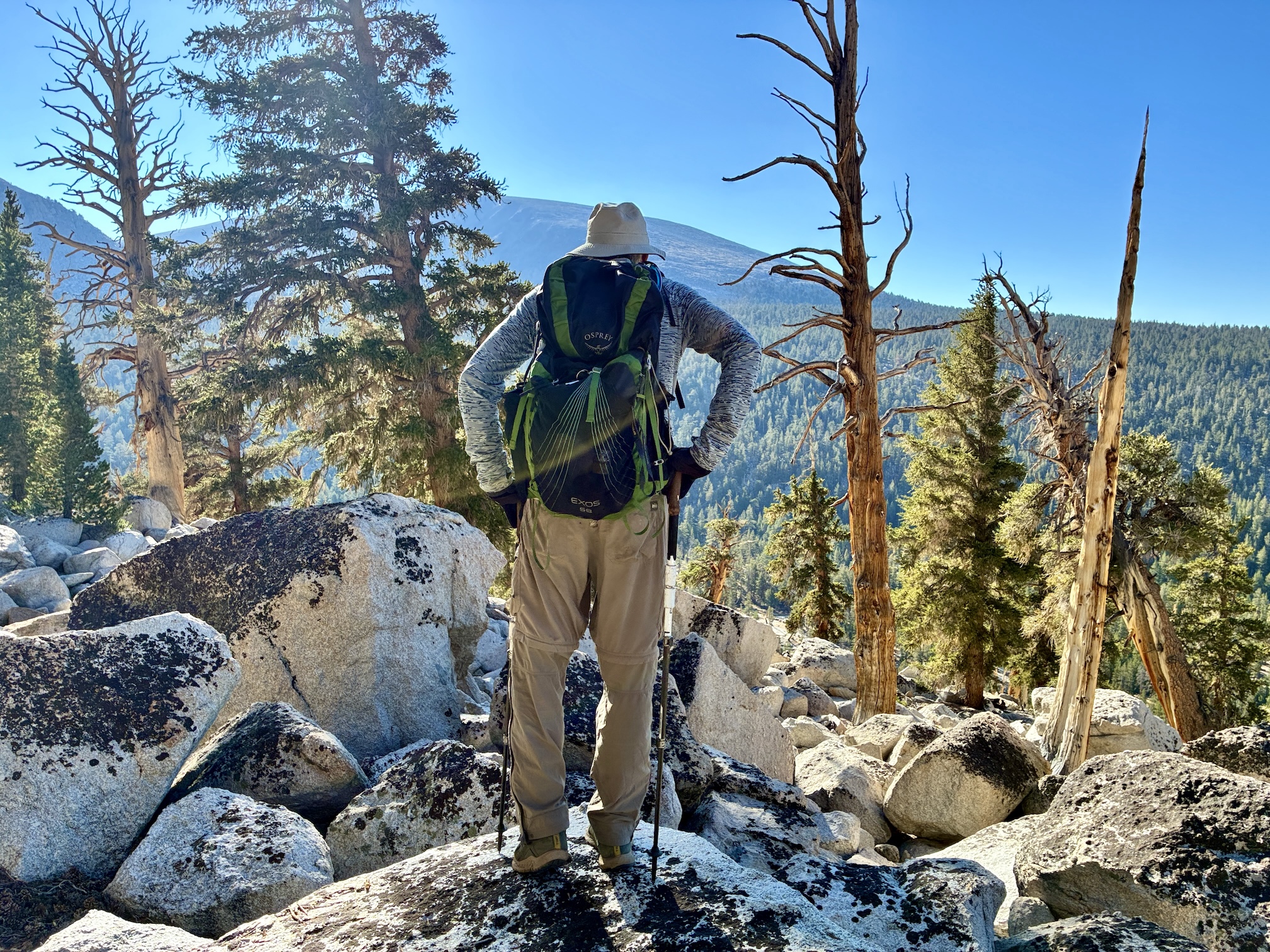
Yet, Safford knows better. A University of California, Davis, forest ecologist recently retired from 21 years with the U.S. Forest Service, Safford has summited about 600 mountains, been struck by lightning twice, and lived to tell many tales. So his was an informed response in 2024 when, hiking up the south slopes of Mount Kaweah at 12,657 feet in Sequoia National Park, he took one look at a small Jeffrey pine and asked it, “What the hell are you doing here?”
He might as well have spotted an armadillo in Antarctica.
The tree escaped detection by satellite, Google Earth or remote sensing. It took Safford’s keen eye and chance encounter to identify it as the highest tree recorded in California — and it was thousands of feet higher than any Jeffrey pine was known to exist. Safford thought it was most likely planted by a bird: the Clark’s nutcracker, one of the High Sierra’s most avid gardeners. He knew there were more “Jeffries” out there and vowed to return to find them.
For four days, I tagged along, documenting the trip through writing, photos, videos and even creating watercolor sketches, as he and his lab students returned to the mountains for answers. It was a fraction of the 30 days they would ultimately spend backpacking this summer. They scoured 24 peaks and hiked more than 240 miles — from Lake Tahoe, Yosemite, Sequoia and Kings Canyon national parks to here in the Inyo Forest — all in search of high-elevation Jeffrey pines and the meaning of their presence for our changing, warming mountains, and for us.


“If you want to understand what’s happening with climate change, you have to look at our Earth’s extremes — the poles and the mountains,” Safford said. “The subalpine forest is one of the leading edges of climate change.”
The rare skills that power high-elevation science
The hardest thing about Safford, 62, is keeping up with him. His mind and feet move at a mindboggling pace. Even when silent, his body seems to hum with energy, ready to spring into action, or a laugh, or a story.
Most of his research centers on answering wildfire or forest management questions posed by others. But this project, driven by curiosity about his unexpected discovery, is different.
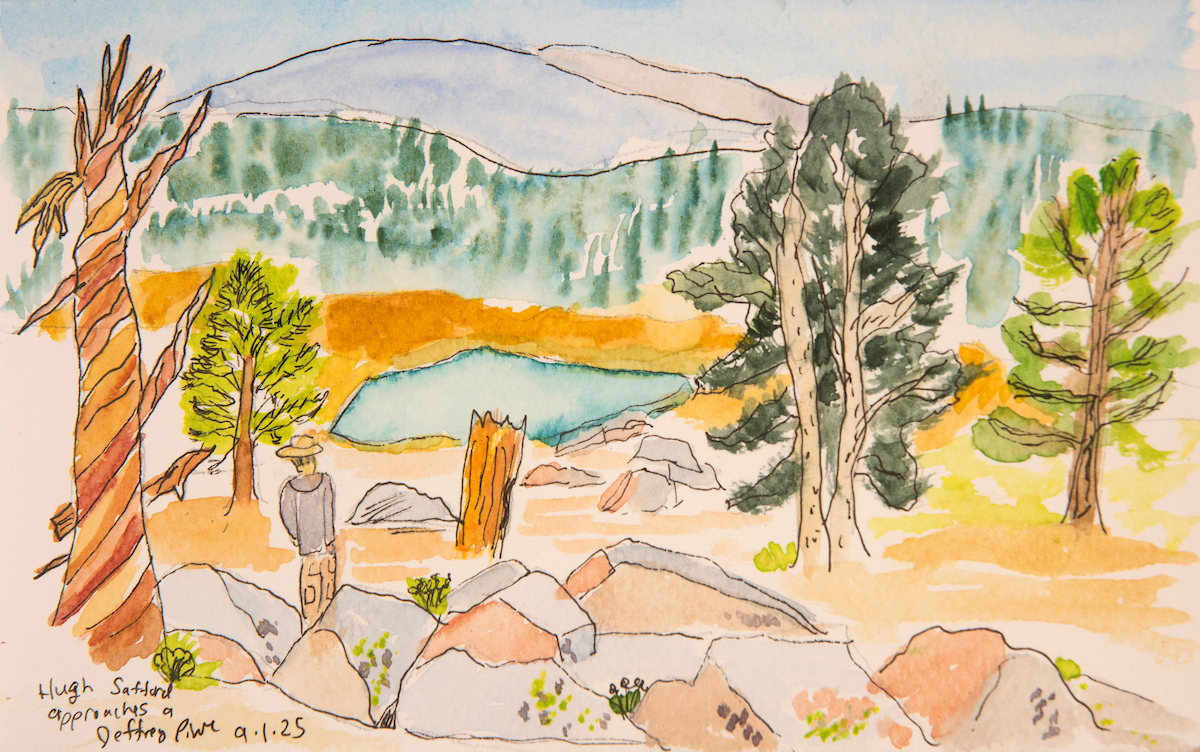
“It’s like playing your own music versus playing someone else’s,” he said. “It’s much more interesting.”
The pool for fit, knowledgeable ecologists with the willingness and time to trek hundreds of miles over the course of a summer to look for a specific pine tree in the mountains is small.
Sachi Srivastava, a master’s student in the UC Davis Graduate Group in Ecology and part of Safford’s lab, ticked all the boxes. A mild-mannered, softspoken woman from Nashville, Tenn., she is an unassuming beast on the mountain. Aside from Safford, she was the only lab member to attend all four of the summer’s progressively harder week-long treks, often leading the pack while also organizing the data collection.

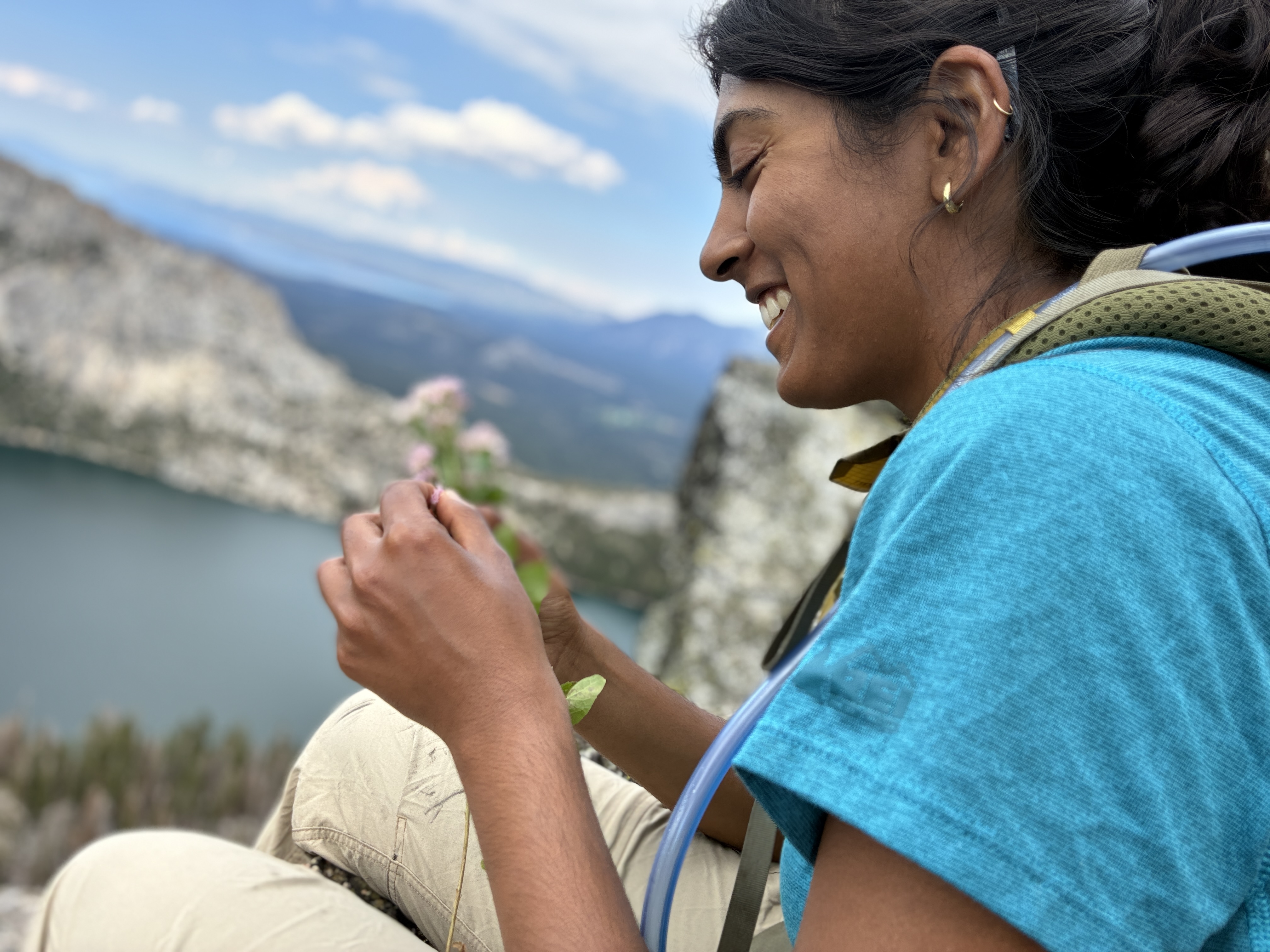
It wasn’t always that way.
“When I first started, I felt like I was fighting with the mountains,” she told me. “But once you learn to work with the mountain, rather than fighting against the rocks and worrying you’re going to fall off, going up becomes easier.”
Her words rang true as we set out for our first full day of fieldwork.
Day 1: The first steps in a climb for climate cues
You think you have a long commute? Try hiking up a mountain for two days with a 40-pound pack on your back to get to your office. That’s how long it will take for us to reach our first high-elevation research site.

Our crew of seven meets at a grassy park in the Eastern Sierra town of Lone Pine. They include Nick Parker, a UC Davis undergraduate student with a quiet, earnest smile and an eagerness for field experience. Bird biologist Mike Mahoney, with his scraggly beard and deep, hearty laugh, is a National Science Foundation fellow new to Safford’s lab at UC Davis. Volunteer Gabrielle Katanic is a gregarious nature lover, whose idea of a dream vacation is climbing multiple mountains in one week. Volunteer Hjördis Rickert, an experienced mountain guide with a gentle soul, rounds out the team.
We drive past the Alabama Hills, under the shadow of Mount Whitney, and up an ear-popping highway overlooking the dry expanse of Owens Lake. Finally, we reach Cottonwood Lakes trailhead, where we begin our trek in earnest.
We have several thousand feet to climb before we find Jeffrey pines that are “interesting,” meaning above 11,000 feet or “not where they’re supposed to be.” In the meantime, we pass lodgepole pine, trickling streams, stunning foxtail pine — whirls of rusted sienna and amber curving up their trunks.
“There’s a Jeffrey pine!” Safford calls out, followed by a joyful expletive. We’re still under 10,000 feet, so this isn’t a high-elevation Jeffrey, but Safford and Srivastava use it to demonstrate how to identify, sample and record the tree into the phone app Srivastava programmed for this purpose.


They plan to combine the group’s data with all global records to create a database that climate modelers, natural resource managers and anyone interested in Sierra Nevada trees can use.
If you can count to three, you can identify a Jeffrey pine. It’s the only three-needled conifer we’ll see on this trip. Safford grabs a branch and points out three needles anchored by a small node at the needles’ base. Easy peasy.

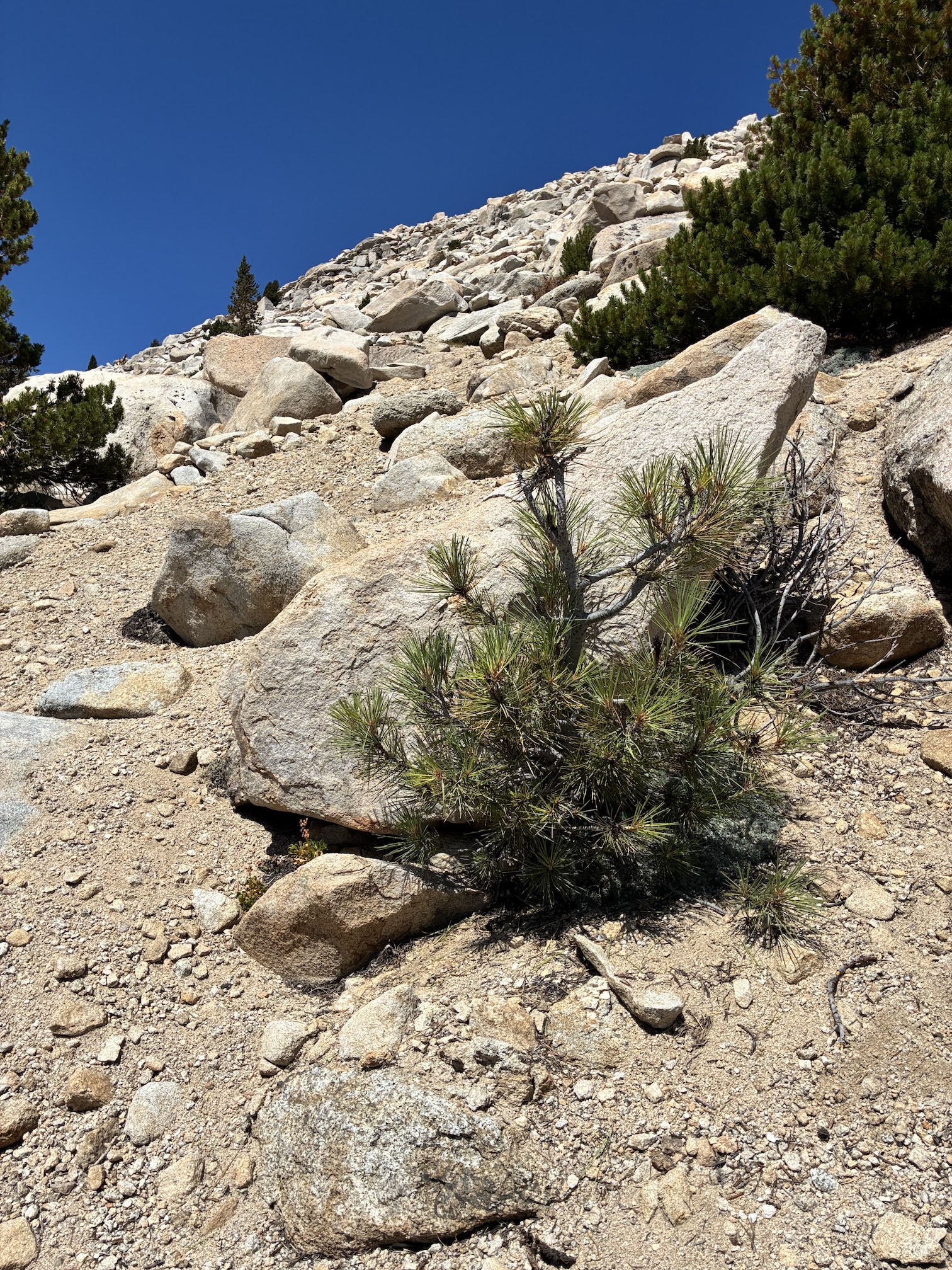
Estimating age is inexact but also fairly simple. Whorls of branches around the trunk usually connote a year of growth. This one is probably 50 to 60 years old.
They measure it, log its coordinates, check its condition and note that it has no cones. Few high-elevation Jeffrey pines do, but Safford thinks that will change with the warming climate. High-elevation Jeffries also tend to be much shorter than this one.
“Life up there is hard,” Srivastava says of the timberline. “Like nothing, really nothing, is doing its very best. So it’s important for us to be up there in the most extreme part of the Sierra looking for how forests are changing because they can tell us more about how the world is changing as the climate warms.”
Can’t a satellite, drone or AI do some of this work for them? Not really. What looks like a tree in a satellite image may be a shadow or a rock. What appears as one tree may be a clump of five. Discerning a species — especially a tiny sapling — without close inspection is difficult.
“You’re not going to have very good information if the data are not field-validated,” Srivastava says. “Why model anything if it’s not based on reality?”
AI, for instance, can take the data the team gathers on the mountains and arrange it into a usable model, but it can’t collect the data themselves. Neither can it hear the call of the nutcracker, watch where it carries its seeds, or witness the complex interplay of plants, animals, sounds and smells that may hold clues to discovery.
“The tree that holds our big interest is really small,” Safford says. “There’s absolutely no way to know they’re there unless you go look for them.”
So on we walk. The green shady forest transforms into a cream-colored, otherworldly landscape. Only a smattering of gnarled foxtail pines dot the terrain.
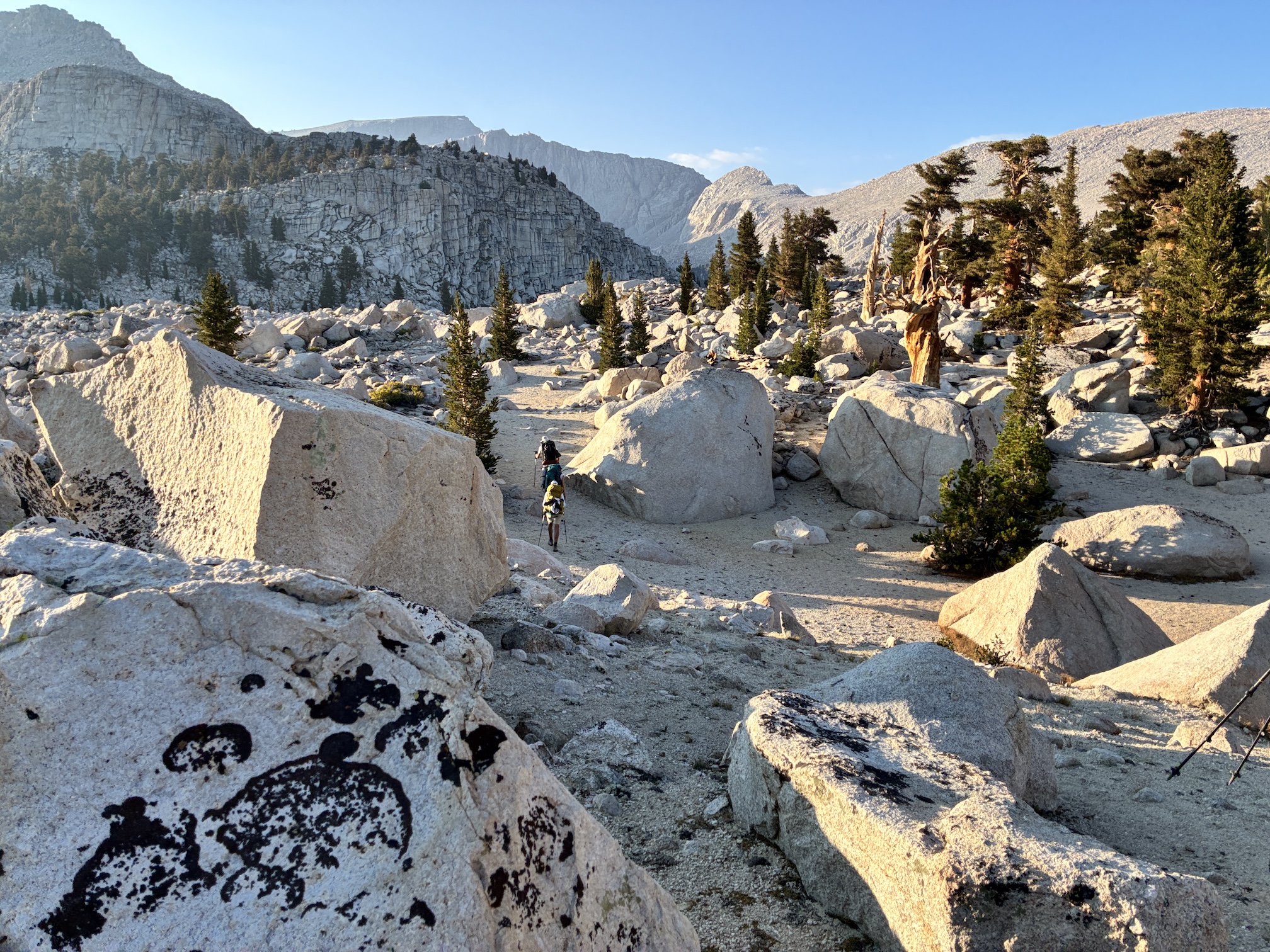
We go off trail, where I encounter my first boulder field — a sea of large rocks tumbled across a glacier moraine that appears to extend precisely forever. Are we supposed to hike across that? Yes. Yes, we are.
My first few steps are taken in terror. So many of the boulders are high. So many of my bones are breakable. My brain goes numb as I debate what to do with my trekking poles. Stick them under my arm? What if I trip over them? Safford spots my quiet panic.
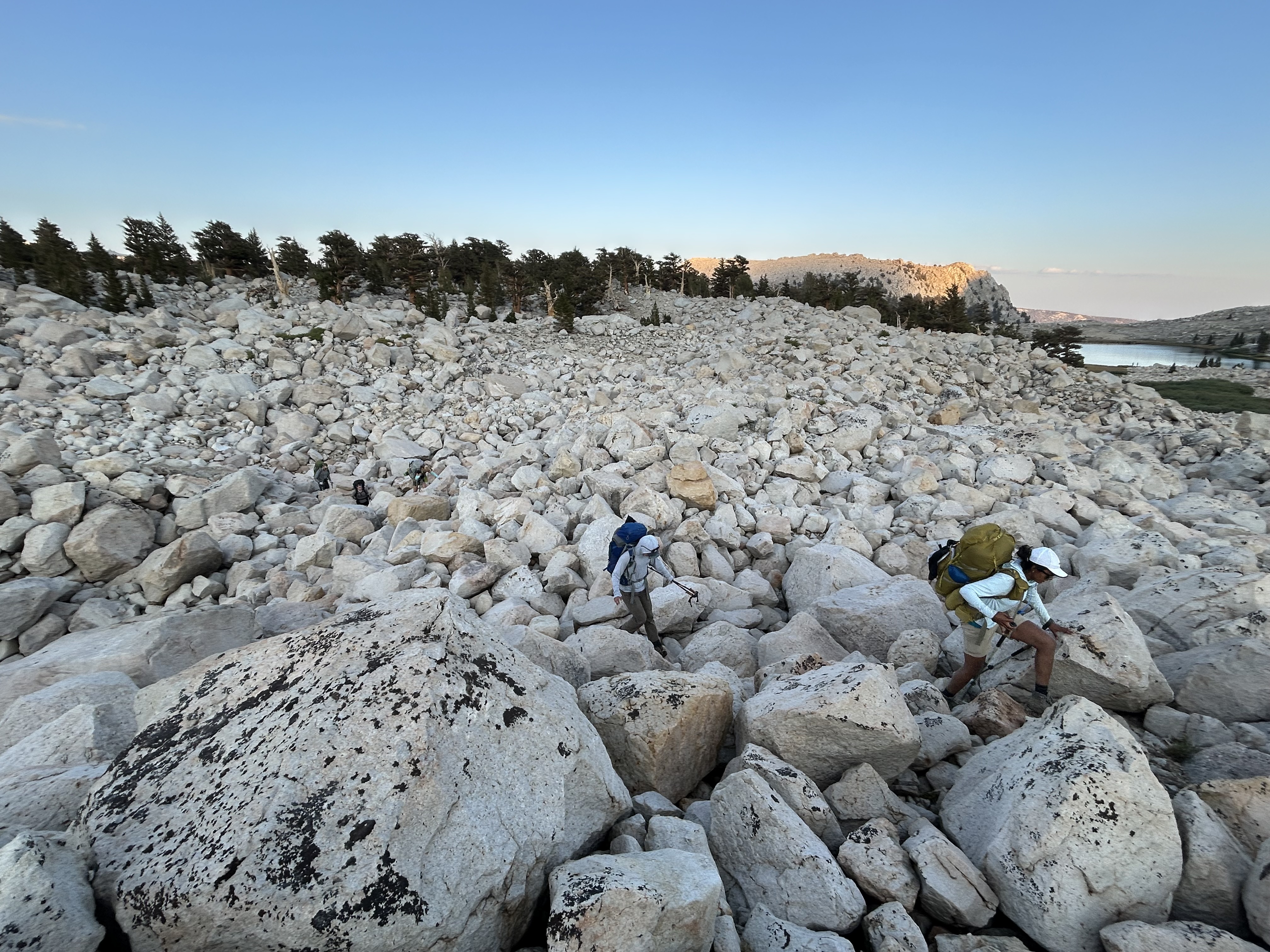
“Use your poles like an extended hand,” he says, casually stretching his out to one boulder and hopping across another. We move like six-legged insects across the landscape.
We reach camp, set up our tents, and sit down together to eat. I choke down half-cooked dehydrated alfredo pasta. Tomorrow will be our toughest day.
Day 2: Trudging toward Mount Langley to chase Jeffrey pines

Dawn breaks over a golden lake meadow. We wake early and begin the roughly 10-mile slog over New Army Pass and on to Mount Langley. At 14,032 feet, it’s California’s ninth-highest peak: a “14-er.”
We trudge up a trail of craggy granite. Some of it appears to fold onto itself, like the laminated pastry of a flaky biscuit or a stack of pancakes. Safford, Rickert and Katanic talk excitedly about trees, geology and nature. I barely have energy to put one foot in front of the other, let alone speak. I love when Katanic, whose amaze-o-meter is always on full throttle, squeals, stops, and pets nearly every “cute” plant or rock she sees. It means I can rest!

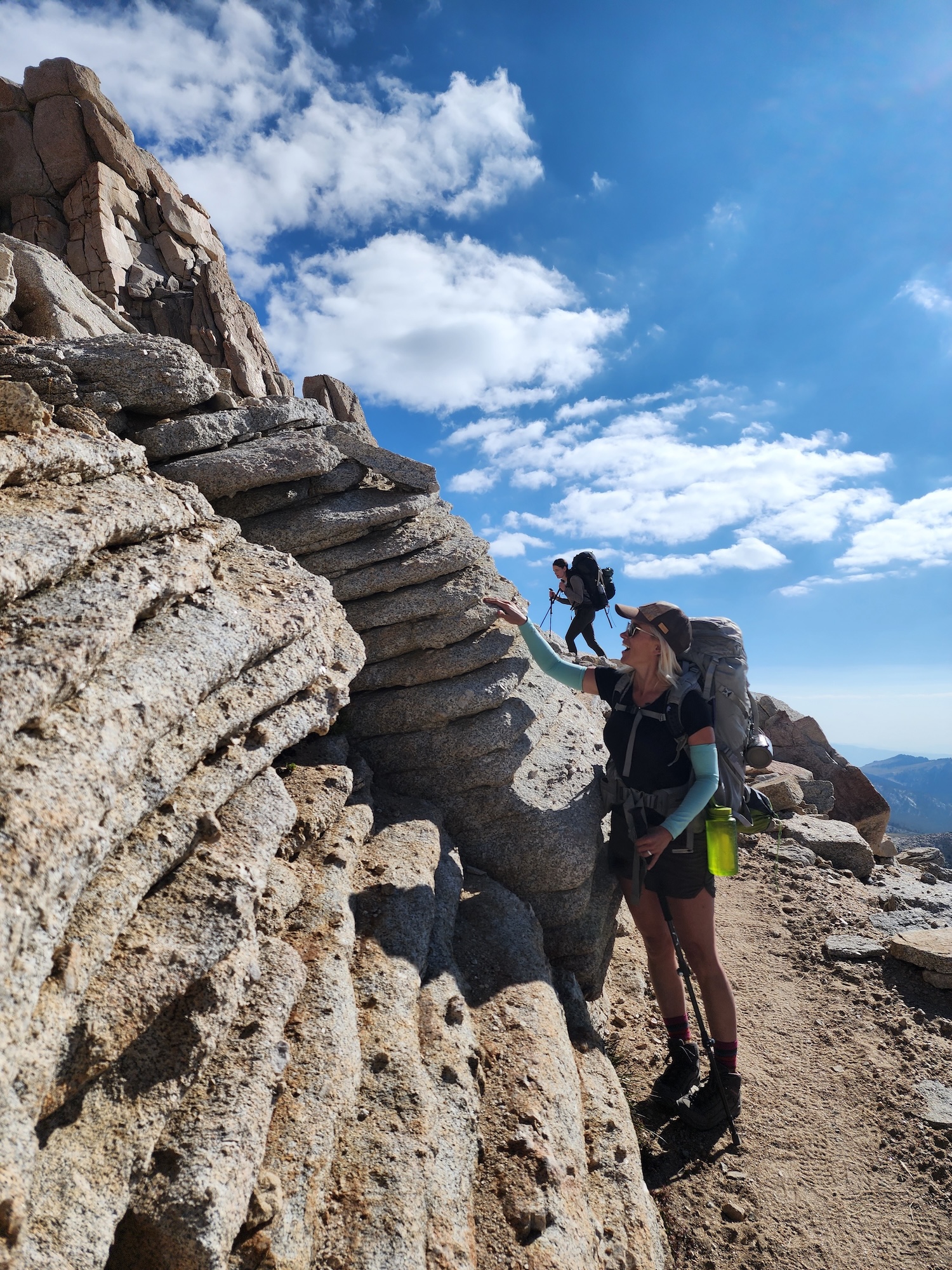
We reach the top of New Army Pass and marvel at the view — there’s Mount Langley, Mount Whitney, the Kaweahs and Joe Devel Peak all before us. Srivastava and Safford were at the Kaweah Peaks only two weeks ago, looking for — and finding — high-elevation Jeffrey pines.
We push through the arid pass, then drop our packs and scramble up the side of Mount Langley. Every step requires focus to grab the right rock and avoid slipping.
Safford said he hoped to find the highest tree yet here along Mount Langley’s steep south slope. We find wasps and coyote mint, pika nests, a chonky marmot that wobbles right across our path, and chunks of sparkling quartz. We note sweet, hardy flowers growing between rock enclosures and bright neon and pink lichen dotting slabs of granite. But we haven’t seen a single Jeffrey pine up here. It’s disappointing.

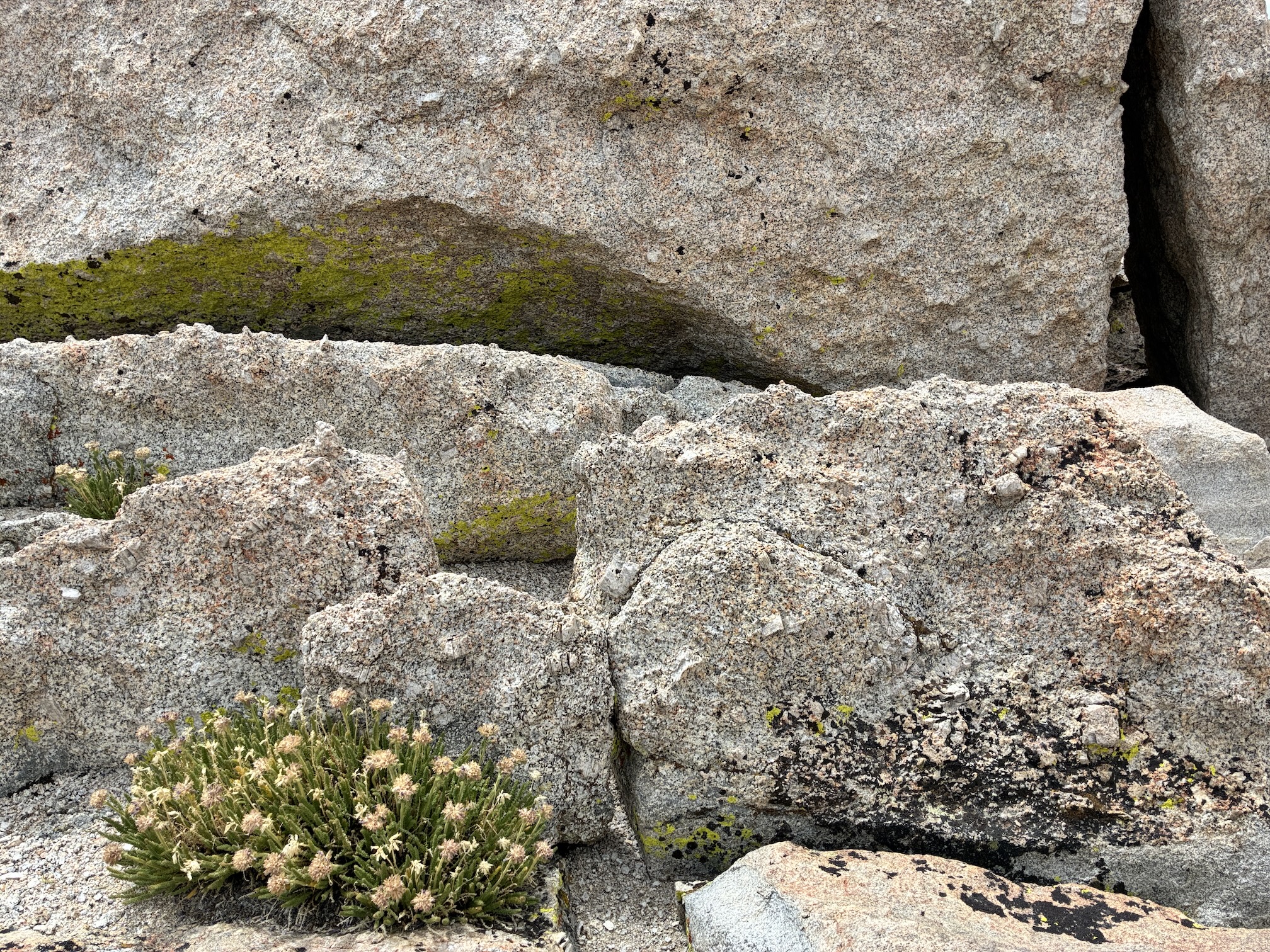
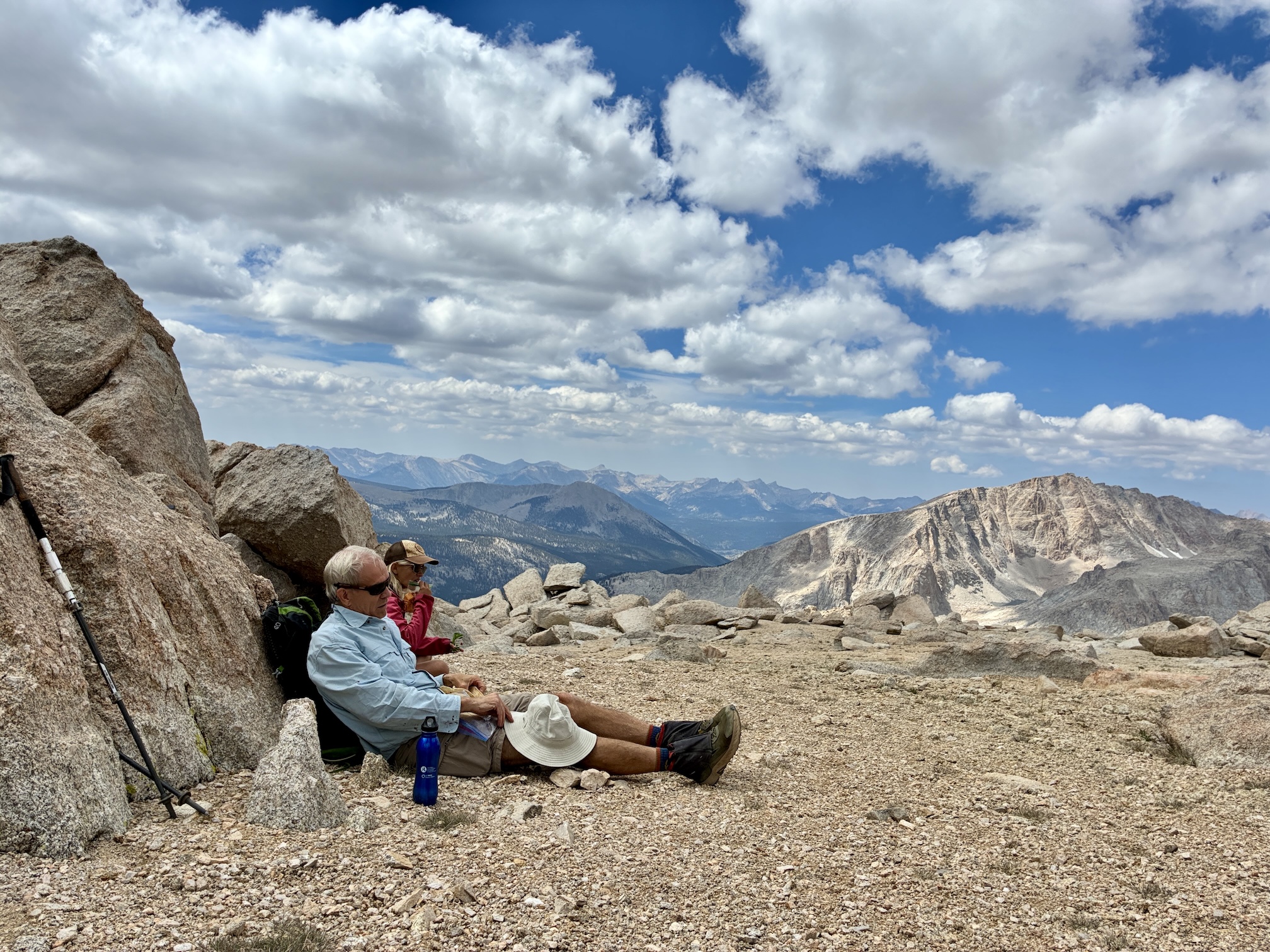
“You guys are not maximizing your real estate!” calls Srivastava to any Jeffrey pines within earshot.
We move on and spread out.
Then, in the way one might exclaim, “Happy birthday!” during a surprise party, Safford suddenly calls out, “Jeffrey pine!”
It’s the first high-elevation Jeffrey pine of the trip. “Whoop, whoop!” come echoing cheers of the crew.
Safford again: “Four Jeffrey pine! There, there, there and there! They’re always at the top! It’s so crazy!”

Safford and Srivastava didn’t find Jeffrey pines in the Kaweah mountains until they were at timberline, where they encountered a whole grove. Why, he wonders, are they mostly found at the lower and highest elevations, while skipping huge zones in between?
“It was so cool, seeing those tiny little Jeffries way up there and imagining how far they must have come from their source,” Parker said later. “It’s crazy to think how they got there.”
Climate models make assumptions about how species will move with increased warming, but how and why a species moves is complex. Clark’s nutcrackers may have been storing Jeffrey pine seeds in their mountaintop “refrigerators” for millennia. But as slopes become warmer, and snow melts earlier, Jeffrey pine seeds are germinating in places they would have found inhospitable just a few decades ago.
“It’s not just about moving a species uphill,” Safford says. “Trees don’t walk or run; their seeds move. We forget there are species with the capacity to just leap over these boundaries.”
Day 3: The corvid and the conifer
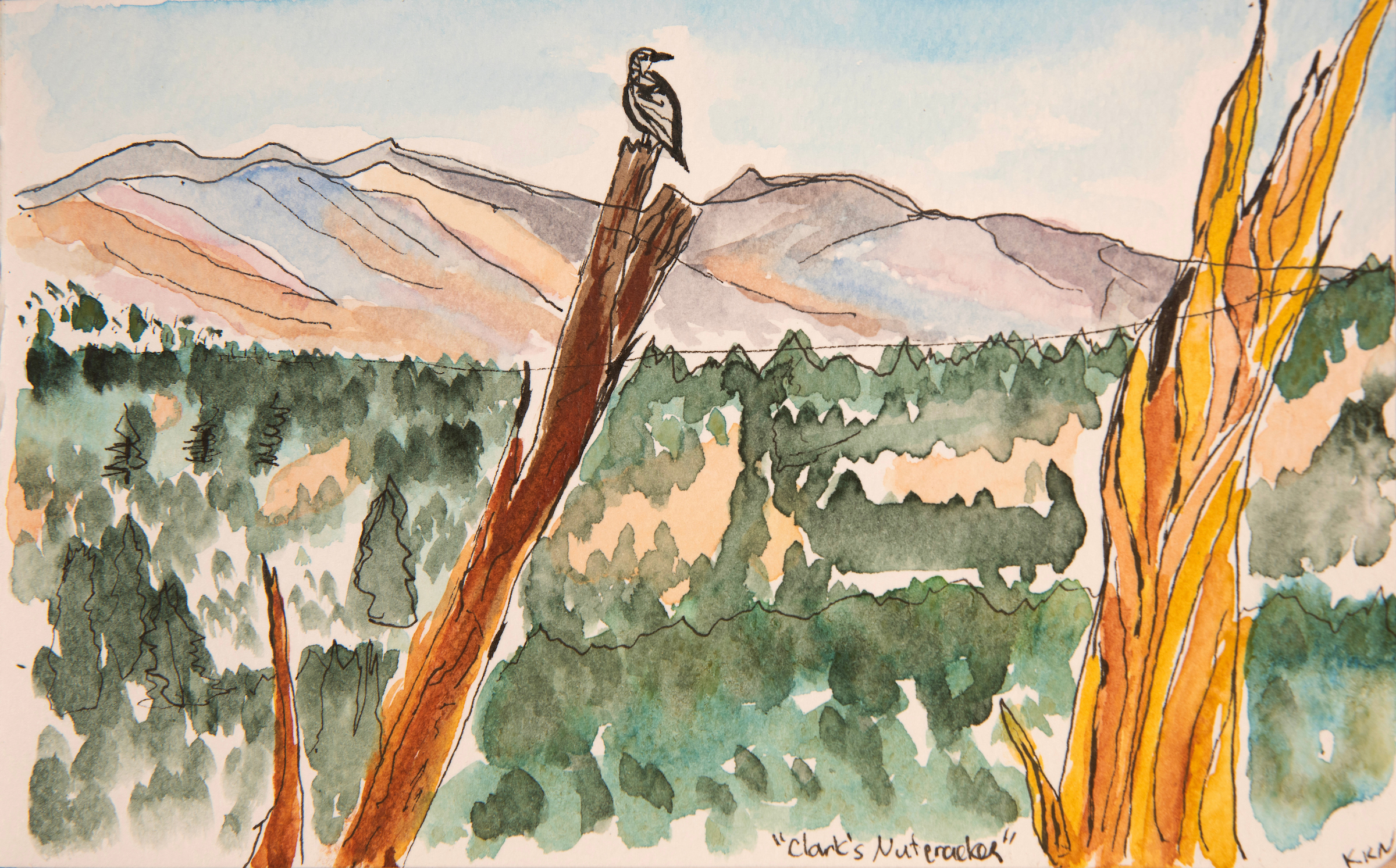
We camp around another glorious mountain meadow and glassy lake and set out in the morning to sample Joe Devel Peak. A lone Clark’s nutcracker perches on a tree snag. Mahoney likens its call to “a raven holding its nose.” We enter a shady forest and keep our eyes peeled for Jeffries.
Suddenly, Mahoney goes still and alert, like a bird dog looking up at the sky.
“I just saw a bird cache,” he says.
Mahoney takes off, following the Clark’s nutcracker. He loses it for a moment then hears its caw again. We hop across a small boulder field to where he thinks he saw the bird drop its cache of seeds. He starts digging beside a rock, looking for the cache and the clues its contents may hold.
As he digs, the nutcracker calls again, urgently. Another nutcracker joins in. Soon, the sky is filled with the sounds of about six Clark’s nutcrackers, who seem to be launching an emergency action plan. Their food is under threat — by us. We stop in our tracks. One flies closely over us, its wings swooshing above our heads.
“They’re pissed!” exclaims Parker.
Mahoney stops digging, steps a few feet back, and the birds call off their alarm. The forest grows quiet.
“If I were to assign a feeling to that bird,” Mahoney says, “I’d say it was not so happy with our appearance.”

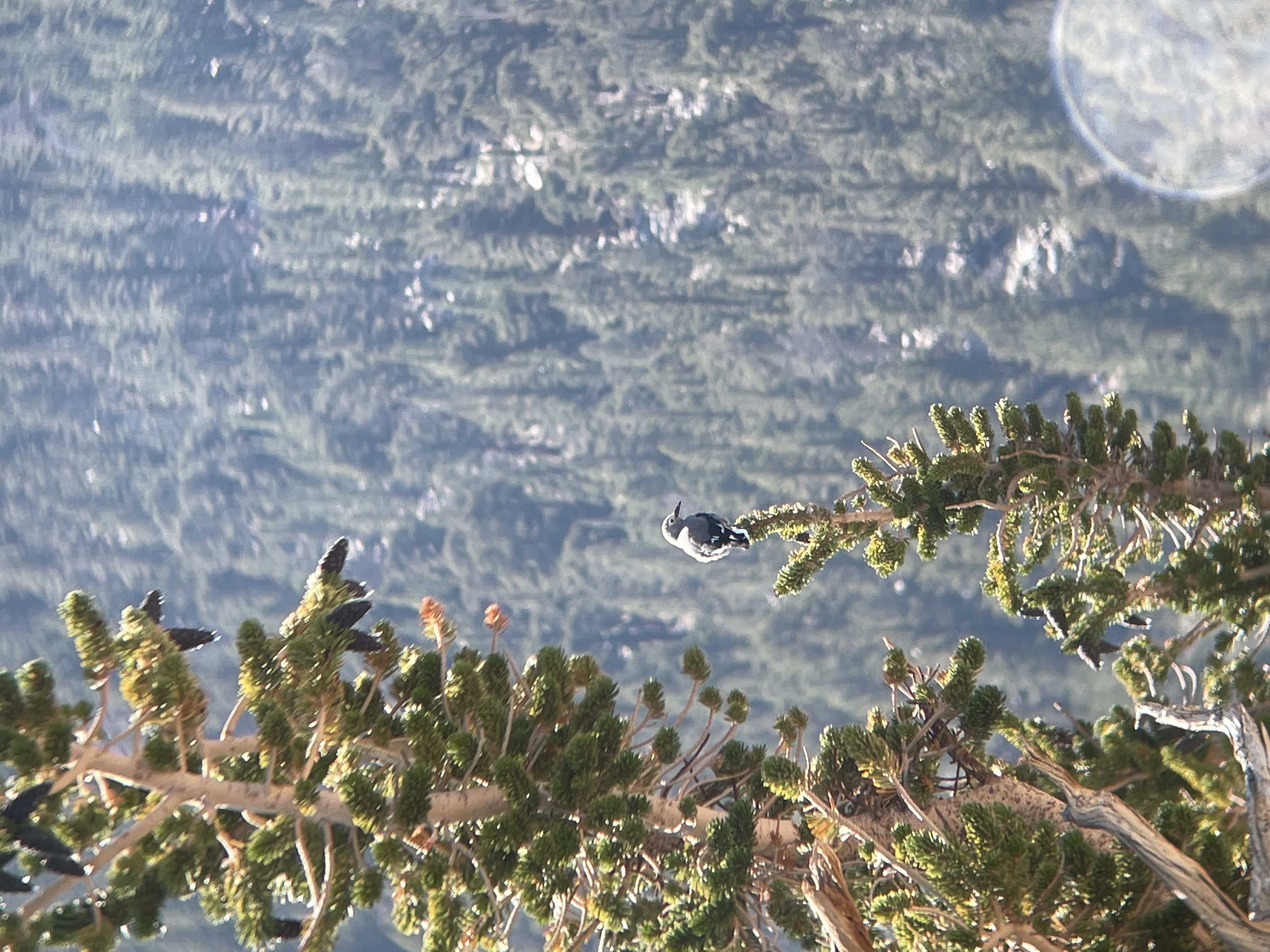
The experience raises questions for this bird biologist. Why do they cache where they do? How territorial or communal are they about their food storage? Bird caching behavior is key to answering why Jeffrey pines grow at such high elevations.
As Safford explained earlier, “it all comes down to what we call optimal foraging.” Most animals, people included, aim to get the most calories for the least effort. At these elevations, Clark’s nutcrackers usually prefer whitebark pine, which has a large seed. Limber pine is next on their menu, with a slightly smaller seed. Finally, there’s Jeffrey pine. Its seed is about 20% smaller than a whitebark pine but includes a thin, papery wing. This helps it disperse in the wind but is difficult for the bird to remove, so the seed is harder to eat. Yet, for some reason, the birds appear to be caching Jeffrey pine all over the High Sierra.
“This system is exciting,” says Mahoney. “It feels like there’s a lot of opportunity to get to understand California’s forests in the Sierra Nevada through the lens of this bird and its seed dispersal system.”
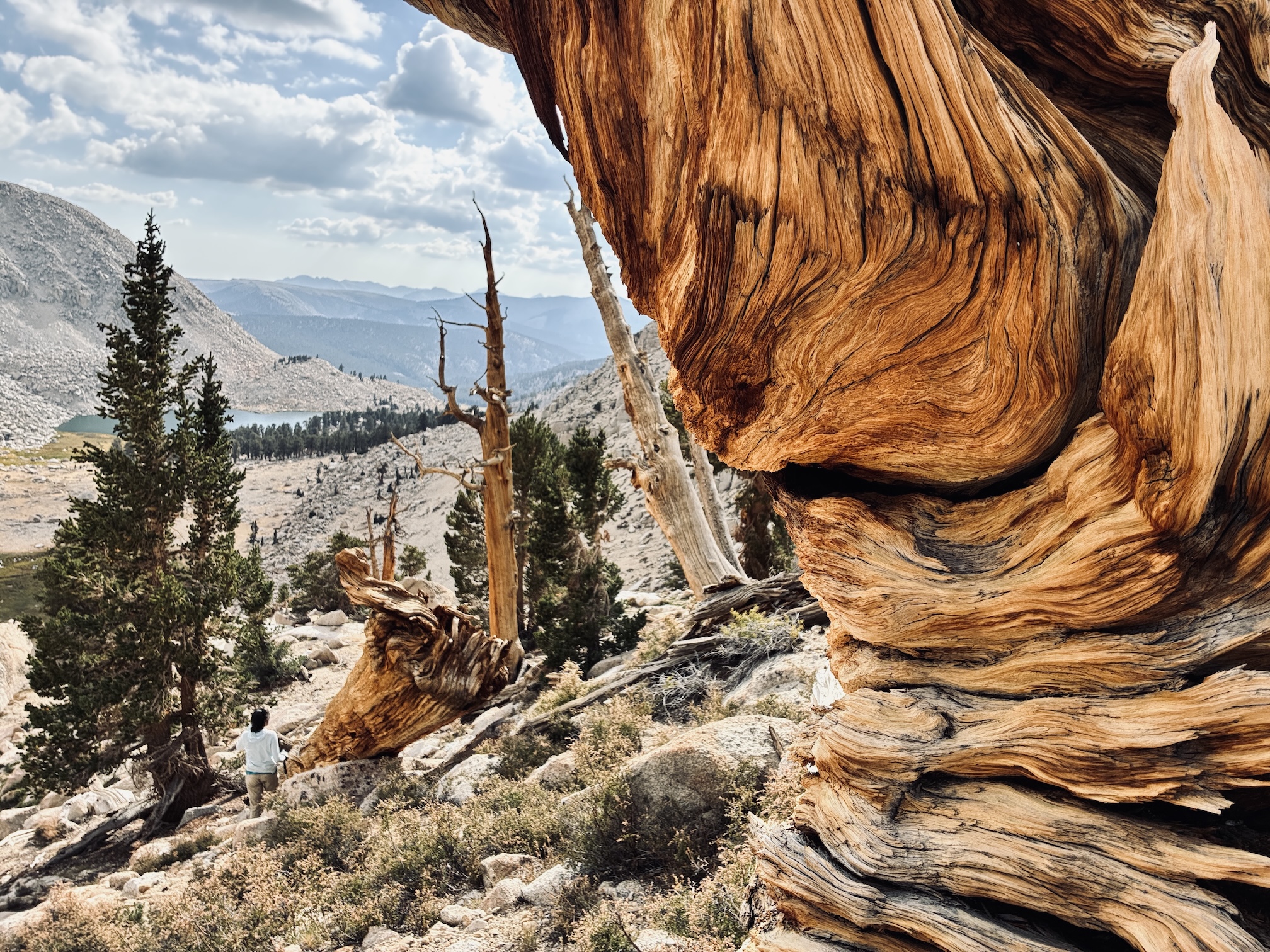
Lessons from thin air
We continue our Jeffrey pine search, and even I find one! It’s my first contribution to science, data-point wise, and I’m chuffed. My little Jeffrey is about 12 years old. About 60% of its crown is damaged. It’s stunted, growing atop its high slope of bedrock, but it’s here.
“This is way above where they want to be,” Safford says. “It would be like taking someone's child and dropping them off in Greenland.”

The team continues up the 13,327-foot peak. I stop just short of the summit. Like the Jeffries, this is way above where I want to be, too. We hike down, and I feel immediate relief. I still have 12 miles to hike out tomorrow with Srivastava, but I feel confident about our descent. The rest of the group will continue for another four days to Mount Whitney, the highest peak in the continental United States.
At camp, we sit together over dinner and reflect on our journey. This work is exhilarating, awe-inspiring, fascinating, but it’s not easy. It tests and rewards the body and mind.

I admit it: I cried twice in four days — just in brief, tired, frustrated, moments when confronted with gravity-defying tasks. But still. Over time and with help, I learned to trust my feet, the rocks and my limits. Srivastava said with a laugh that she felt the same way two weeks and 200 miles ago.
“If it makes you feel any better, of all the 14-ers I’ve done, I’ve probably cried on almost all of them,” says Katanic, whose Instagram account TalkNerdyToMeCalifornia documents her adventures. “I get tired or scared, and I’ll just sit down and go, ‘Give me a minute.’ Then I’ll be back at camp like, ‘That was great! Let’s go do it again next weekend!’”

Her words do make me feel better. But mostly I think about how astounding researchers are for being willing to look closely at the planet — really close — in places most of us never go, to try to make sense of it.
“It’s been kind of exhausting, but I love it,” Safford says.
Science requires all the senses and all the tools, human and non-human alike, to understand the changes afoot at and between Earth’s extremes. And how cool is that? That there’s still a world and a place for exploration, for wonder, for understanding, for inquiry, for walking the land and learning its secrets.

Media Resources
Hugh Safford, UC Davis Environmental Science and Policy, hdsafford@ucdavis.edu
Kat Kerlin, UC Davis News and Media Relations, 530-750-9195, kekerlin@ucdavis.edu
